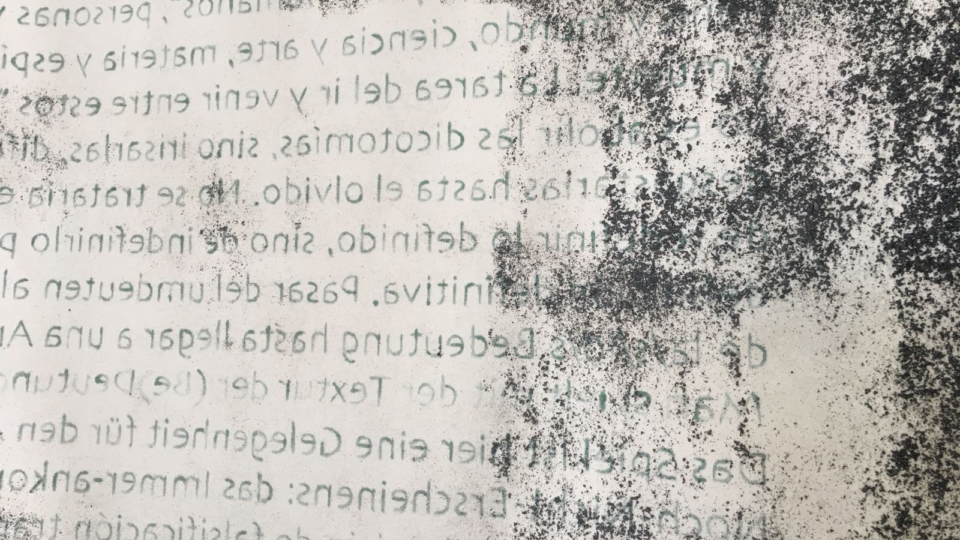Transkutir

Modernity had its planned obsolescence: the obsolescence of tradition and of the idea of tradition. Accepting this cleavage momentum, the falsification of traditions appears as a pre-grammatical instance that is simultaneously a leap into the future-past. This falsification does not operate in the repertory of the traditions themselves, but on the purity and sacredness of its memorial and institutional use. It does not imply a reference to something true, but to some kind of “aural latency”. For example, the falsification of illumination would lead to the following question: How much darkness can fit into the dark? When analyzing its response, it starts to emerge from the mirror. If the invention of tradition constituted an order that pulls backward to the past, while pushing forward to the future, the inversion of tradition is the current that “naturally” returns at the breaking of the wave. In the silence after this breaking resides the pre-grammatical instance that predisposes the foundation of things to come.
In the coming and going of our experiences between America and Europe the mestizaje appears less as a diffuse identity, but rather as an act of transparency, whose unit is the “in-between”. By crossing the paths of the “in-betweens” we get to the founding principles of modernity: nature-culture, subject-object, us-them. These oppositions are deployed in others, such as “human” and “non-human”, people and things, sign and world, science and art, matter and spirit, life and death. The task of this coming and going between these “inbetweens” is not to abolish the dichotomies, but to iridesce, to diffract and to erode them into oblivion. Thus it would not be a matter of redefining the defined, but of in-defining it for its final un-definition. It is a movement from an umdeuten to an undeuten of the Bedeutung, in order to arrive at an Andeutlichkeit; a play with the texture of the meaning, which is an opportunity to call on the not-yet-appeared: the ever-arriving.
Beginning with an exercise of transparent falsification, it starts to self-energise an aesthetic-cognitive principle: the transkutir. This mestizo concept is composed of the AymaraQuechua term “kuti” and the Latin-based prefix “trans-” of, for example, transition, transformation, or translation. Both elements sedimented along their traditions a sense of change, movement, upending and dynamics over time. In this process of mestizaje, individual identities are diluted through a form of cannibal metanoia or nooifagia. With differing origins and perspectives on their very meanings, that are rooted in various Weltanschauungen, cosmovisions or imayna rikuna panti, the mestizaje that emerges from “trans-” and “kuti” aims to (ex)cavate the traditions and to create (poiein) aesthetic-cognitive processes of reversion and inversion that disentangles and expose the tradition and the idea of tradition. In this way, its heritage appears more as an inversion than as a treasure. Transkutir recovers two ways of conceiving the upending and the transformation in order to generate its mestizo re-cognition: to return in altering and to alter in returning.
March 2015
Cruz del Sur
Text by Tomás Bartoletti (translated by Jenny Wolka)
This text on the neologism „transkutir“ is the product of a series of meetings under the name Cruz del Sur, which took place in the beginning of 2015 in the studio of Mahony Collective, Berlin.
Originally convened by Tomás Bartoletti, David Magnus, Pablo Rojas and Jenny Wolka, artists, curators and academics participated in these meetings, creating a platform for the exchange of ideas and a critical space for artistic practices whose topics were linked to the construction of Otherness and post-colonial aesthetics. The dynamics of these meetings were also based on the exploration of cross-cultural dialogic forms and problems of their translatability.
In July 2015 a conference paper entitled Transkutierte Antike: lateinamerikanische Perspektiven der Altertumswissenschaften with the theoretical development of the concept of “transkutir” was presented by Tomás Bartoletti at Humboldt-Universität, Berlin.
Click here to read the original version of this text in Spanish
Image: Tomás Bartoletti & Mahony i.c.w. David Magnus & Pablo Rojas, Transkutir, mixed media installation, 2015-2018 (detail). Photo by Sanna Gertenbach
The mixed media installation Transkutir is part of the group exhibition Notes from a trembling community in a wilful state of flux held at Hotel Maria Kapel between 7 September and 20 October 2018.
